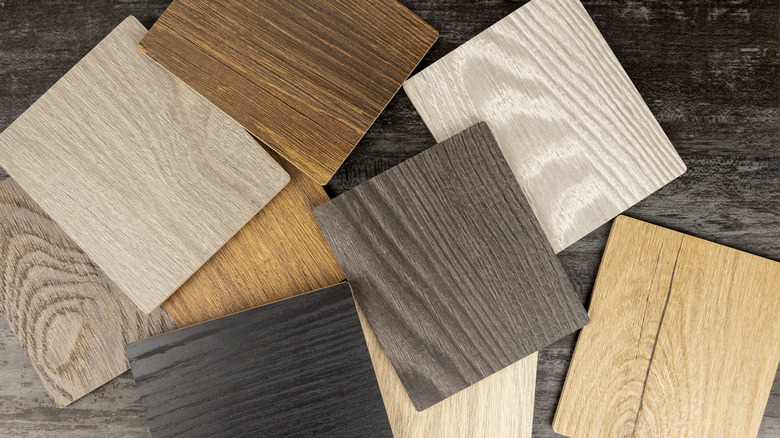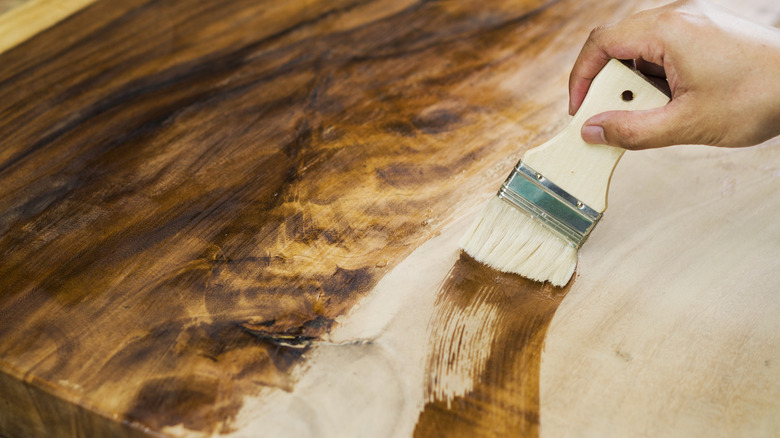How To Cover Laminate With Wood Veneer For A More Expensive Look
Laminate is often considered something similar to a fast-food version of wood furniture. It's affordable and typically quicker to put together, and the quality can be hit or miss depending on how much you paid for it. Quality laminate may hold up well against wear and tear, but it doesn't mean that it'll look expensive. And a cheap laminate furniture piece can disappoint you more by the day. But there's hope. If you're looking for solutions to an outdated kitchen full of laminate countertops or a drab dining room table you wish you'd splurged a bit more on, covering them with a sleek wood-grain veneer may be the saving grace you've been searching for. This easy project simply involves cutting the veneer sheet to the appropriate length for your furniture piece and using an adhesive to secure it in place.
Wood veneer is simply a thin layer of wood with a paper backing (in most cases) that offers an affordable way to reface furniture. The prices for these sheets can vary depending on the wood type and size. A few tools needed for this project include scissors, a respirator to manage fumes, contact cement (such as Weldwood Contact Cement), an edge banding trimmer, a utility knife, split wood dowel rods, a wood plank (or a flexible scraper), an orbital sander, protective gloves, a paint roller and tray, and a couple of vise clamps.
Steps to upgrade laminate with veneer sheets
Once you have your materials, you can DIY this project in just a weekend. Start by laying your veneer sheet over the laminate furniture piece to determine your cut areas. Next, secure the veneer in place with vise grips, and use the utility knife to create rough cuts on the sheet based on the furniture's dimensions. Wipe the furniture with a damp cloth, removing any dust. Next, prepare your adhesive in the paint tray. Flip the veneer over and remove the paper backing. Lay the sheet on a work table, placing vise grips on the edges to hold it in place.
Next, using the paint roller, apply a layer of adhesive to the backing. Lay the veneer on the floor while you prepare your furniture. Place the split rods on top of the furniture, spacing them evenly apart. Then, gently lay the veneer on top of the rods. Next, starting with the closest section, slide your wood plank forward over the veneer while pressing down firmly to create a good bond, smoothing it out over the furniture. Go over about 6 to 8 inches at a time, working your way side to side. When you reach each rod, remove it; do this for other sections until it's complete.
Next, use the edge banding trimmer to trim the overlapping edges of the veneer. Afterward, if needed, use a utility knife to ensure they're flush with the furniture. Place the buffer cloth over your sander, and go over the veneer lightly once or twice. Remove any dust with a damp cloth. Finally, apply your preferred stain.
Ways to customize your veneer furniture
One creative way to customize your new veneer-covered furniture is to add a stain or cool paint job. If you find the typical wood grain texture boring, you can still enjoy the financial benefits of veneer without the traditional woodsy aesthetic. Depending on the shades of your decor setup, you could go with eye-popping colors, including bright blues, bold yellows, or casual crimson. Or, if you prefer a more homespun vibe, consider using distressed veneer for more texture or depth. This is a great option if you're struggling to find affordable reclaimed wood that you like. And why not mix and match different veneer wood types?
Different colors and textures of veneer sheets can create an eclectic look in a space that has a modern vibe. Perhaps mix things up by adding various types of trim or molding. You can go with other veneer wood tones, or even add a few pieces of metal molding to specific furniture, such as tables or benches.
Using the veneer sheets on smaller sections of these furniture pieces as accents, like the legs of table chairs or the arms of a bench, is another stylish alternative. Who cares about interior design rules? Tap into your creativity by playing around with the various types of multi-toned veneer options, or ones with intricate patterns and designs.

